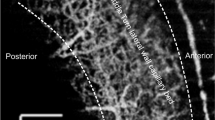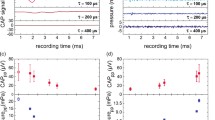Summary
The experiments using guinea pigs and rabbits were carried out to examine cochlear microphonics during hyperbaric oxygenation. The changes of cochlear microphonics were divided into four stages: initial response, oxygen effect, negative oxygen effect and recovery.
High pressure oxygen over 3.0 ATA · O2 is absolutely harmful to the inner ear. Initial impairment of the inner ear function during oxygen compression can be prevented by sympathetic ganglionectomy, however, the drop of cochlear microphonics during oxygen decompression cannot be prevented.
Zusammenfassung
Um das Verhalten der Mikrophonpotentiale der Cochlea unter der Einwirkung von hyperbarem Sauerstoff zu überprüfen, wurden Experimente an Meerschweinchen und Kaninchen durchgeführt. Das Verhalten der Microphonics wurde in 4 Stadien eingeteilt: Anfängliche Reaktion, O2-Wirkung — negative O2-Wirkung und Erholung.
Sauerstoff mit hohem Druck über 3.0 ATA ist für das Innenohr schädlich. Eine anfängliche Beeinträchtigung der Punktion des Innenohres unter Sauerstoffdruck kann durch die Entfernung sympathischer Ganglien verhindert werden. Das Absinken der Mikrophonpotentiale während der Sauerstoffzufuhr ist jedoch nicht zu vermeiden.
Similar content being viewed by others
References
Appaix, A., Pech, A., Bernard, F.: The use of hyperbaric oxygen in oto-rhinolaryngology. Ann. Otol. Chir. Cervicofac. 87, 735–750 (1970)
Bean, J. W.: Effects of high oxygen pressure on carbon dioxide transport, on blood and tissue acidity and on oxygen consumption and pulmonary ventilation. J. Physiol. (Lond.) 72, 27–48 (1931)
Berezin, I. P., Livshits, I. Ya: Oxygen therapy and barotrauma. Vest. Oto-rinolaryng. 31, 84–88 (1969)
Boerema, I., Meyne, N. G., Brummelkamp, W. K., Bouma, S., Menschsch, M. H.: Life without blood. J. cardiovasc. Surg. 1, 133–146 (1960)
Dickens, F.: The toxic effects of oxygen on brain metabolism and on tissue enzymes. Biochem. J. 40, 171–187 (1946)
Freeman, P., Edmonds, C.: Inner ear barotrauma. Arch. Otolaryng. 95, 556–563 (1972)
Glasenapp, G. B.: Das Verhalten der Mikrophonpotentiale der Meerschweinchen-Schnecke nach Blockade des ganglion stellatum. Arch. klin. exp. Ohr.-, Nas.- u. Kehlk.-Heilk. 186, 216–222 (1966)
Haugaard, N.: Poisoning of cellular reactions by oxygen. Ann. N. Y. Acad. Sci. 117, 736–744 (1965)
Haugaard, N., Hess, M. E., Itskovitz, H.: The toxic action of oxygen on glucose and pyruvate oxidation in heart homogenates. J. biol. Chem. 227, 605–616 (1957)
Holub, M., Svačinka, J.: Results of the hyperbaric oxygen therapy in lesions of the Corti's organ. Cs. Otolaryngologie 20, 3, 108–111 (1971)
Kleinfeldt, D., Dahl, D.: Tierexperimentelle Untersuchungen über das Verhalten der Mikrophonpotentiale nach Stellatumblockade. I. Mikrophonpotentiale nach Stellatnmblockade am gesunden Ohr. Arch. klin. exp. Ohr.-, Nas.- u. Kehlk.- Heilk. 190, 124–132 (1968)
Kleinfeldt, D., Dahl, D.: Experimental studies of the cochlear potential behaviour after Stellatumblockade. II. Cochlear microphonic potential after stellatumblockade to the ear predamaged by noise. Arch. klin. exp. Ohr.-, Nas.- u. Kehlk.- Heilk. 190, 398–406 (1968)
Krejci, F., Bornschein, H.: The cochlear microphonic potentials during sympathetic stimulation. Acta oto-laryng. (Stockh.) 44, 154–156 (1954)
Lendingham, I. M., Davidson, J. K.: Hazard in hyperbaric medicine. Brit. med. J. 1969 I, 324–327
Miller, J. D., Ledingham, I. McA.: Reduction of increased intracranial pressure. Comparison between hyperbaric oxygen and hyperventilation. Arch. Neurol. (Chic.) 24, 210–216 (1971)
Miller, J. D., Ledingham, I. McA., Jennett, W. B.: Effects of hyperbaric oxygen on intracranial pressure and cerebral blood flow in experimental cerebral oedema. J. Neurol. Neurosurg. Psychiat. 33, 745–755 (1970)
Miller, H. E.: Cochlear potentials at 11 atomospheres. Laryngoscope (St. Louis) 81, 979–988 (1971)
Mogami, H., Hayakawa, T., Kanai, N., Kuroda, R., Yamada, R., Ikeda, T., Katsurada, K., Sugimoto, T.: Clinical application of hyperbarie oxygenation in the treatment of acute cerebral damage. J. Neurosurg. 31, 636–643 (1969)
Seymour, J. C., Tappin, J. W.: The effect of sympathetic stimulation upon the cochlear microphonic potentials. Acta oto-laryng. (Stockh.) 42, 167–172 (1952)
Stadie, W. C., Haugaard, N.: Oxygen poisoning. V. The effect of high oxygen pressure upon enzymes; Succinic dehydrogenase and cytochrome oxydase. J. biol. Chem. 161, 153–174 (1945)
Stadie, W. C., Riggs, B. C., Haugaard, N.: Oxygen poisoning. III. The effect of high oxygen pressures upon the metabolism of brain. J. biol. Chem. 160 191–208 (1945)
Teng, S. S., Harris, J. W.: Effect of hyperbaric oxygen on cellular dehydrogenases and sulfhydryls. Exp. Cell Res. 60, 451–454 (1970)
Author information
Authors and Affiliations
Rights and permissions
About this article
Cite this article
Murata, K., Takeda, T. & Iwai, H. Cochlear microphonics in oxygen at high pressure. Arch Otorhinolaryngol 208, 77–88 (1974). https://doi.org/10.1007/BF00453921
Received:
Issue Date:
DOI: https://doi.org/10.1007/BF00453921




